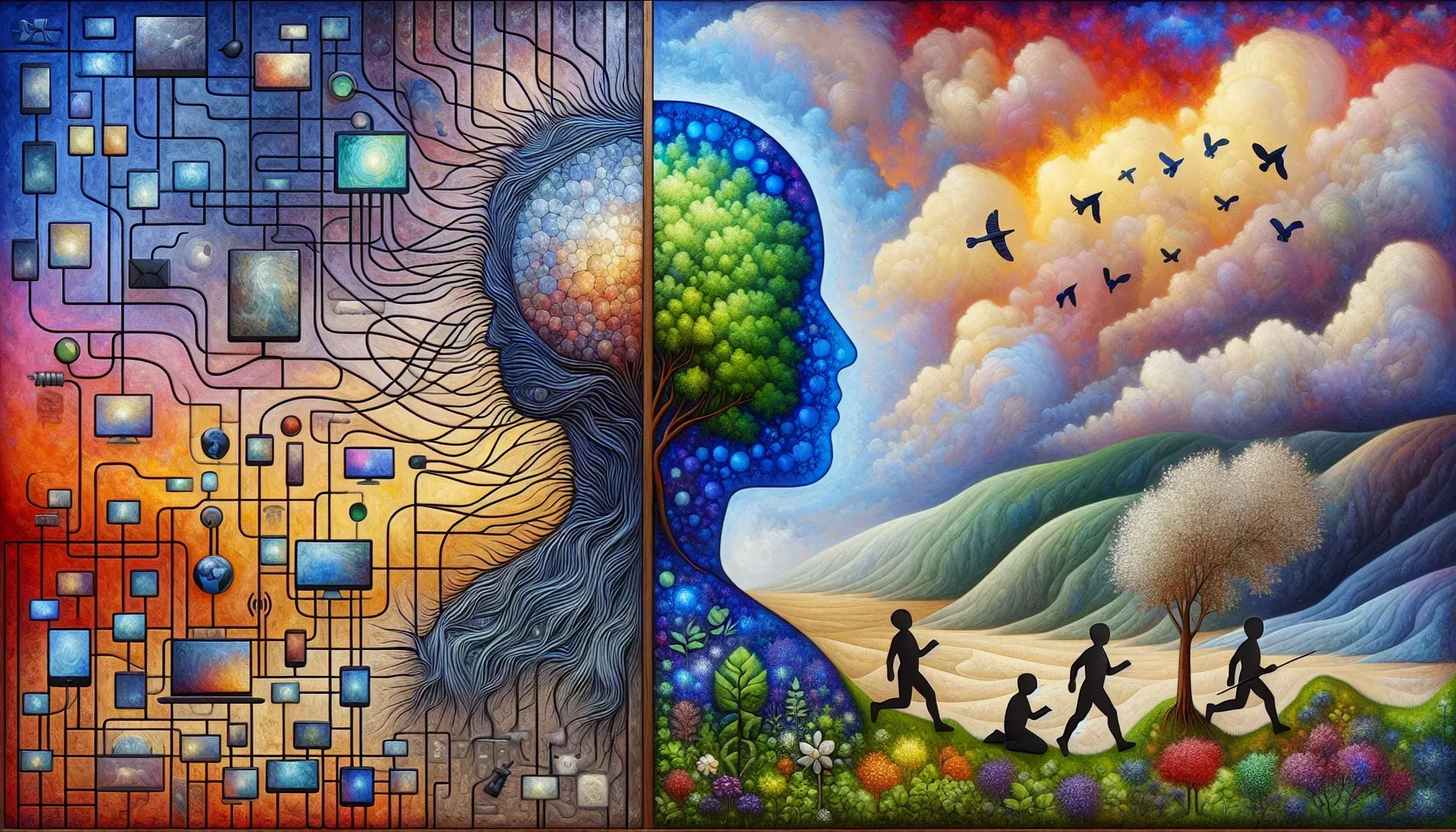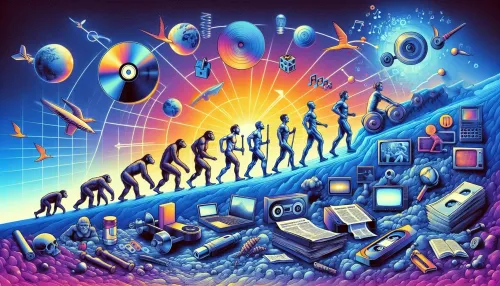Digital Detox vs. Mindful Tech Use: Finding Harmony in Our Connected World

In today's hyper-connected society, where digital devices and technology have become ubiquitous, finding a balance between our digital lives and real-world experiences has never been more challenging. The constant influx of notifications, emails, social media updates, and the overall overstimulation from digital devices often lead to what is commonly known as digital overload. As a result, individuals experience significant impacts on their mental health, productivity, and overall well-being. Understanding the implications of this digital overload is crucial in maintaining a healthy lifestyle. On the flip side, mindful technology use offers strategies to navigate through this interconnected landscape while minimizing the adverse effects and maximizing the advantages.
Understanding Digital Overload and Its Effects
The pervasive nature of digital technology has significantly altered the way we interact with the world around us. Research indicates that excessive screen time and constant exposure to digital stimuli can lead to a range of adverse effects on mental health and productivity. From increased feelings of anxiety and depression to diminished attention spans and decreased productivity, the impacts of digital overload are undeniable.
Impact of Excessive Screen Time on Mental Health
Additionally, excessive use of social media platforms has been associated with detrimental effects on self-esteem and body image, mainly driven by the unrealistic portrayal of lifestyles and comparison with others. Moreover, the blue light emitted from screens disrupts natural sleep patterns, contributing to sleep disturbances and insomnia.
Social Media's Role in Self-Esteem Issues
Understanding the profound implications of digital overload is essential for individuals to make informed decisions about their technology consumption habits.
The Importance of Recognizing Digital Overload
A digital detox involves consciously disconnecting from digital devices and taking a break from technology. This practice allows individuals to recalibrate their relationship with technology and re-engage with real-life experiences. By unplugging from digital distractions, individuals can create space for mindfulness, reconnect with nature, and foster meaningful in-person interactions.
During a digital detox, people often engage in activities such as meditation, outdoor pursuits, art, or simply spending quality time with loved ones without any digital interruptions. Studies have shown that a digital detox can lead to improved mental well-being, reduced stress levels, enhanced focus, and increased creativity.
Related Article: Harnessing Wearable Health Tech: Personalized Monitoring for Well-Being Optimization
Principles of a Digital Detox for Well-Being
Adopting a digital detox as a regular practice can significantly contribute to mental rejuvenation and overall well-being.
Benefits of Regular Digital Detox Practices
Mindful technology use emphasizes conscious awareness of our interactions with digital devices. It encourages individuals to set healthy boundaries and adopt intentional practices that promote a balanced approach to using technology.
One effective strategy for mindful technology use is establishing designated tech-free zones or specific times during the day when individuals consciously disengage from their devices. This approach can facilitate greater presence in real-world activities and enhance interpersonal relationships.
Embracing Mindful Technology Use Strategies
Moreover, practicing digital mindfulness involves being deliberate in our online engagements, consuming content mindfully, and leveraging technology to enhance our lives without allowing it to overshadow our personal well-being.
Establishing Tech-Free Zones for Better Focus
By incorporating intentional practices into technology usage, individuals can mitigate the negative impacts of excessive screen time while harnessing the benefits that technology offers.
The Concept of Digital Mindfulness Explained
The constant connectivity facilitated by digital technology has implications for our psychological well-being. In today's digitally driven world, individuals often experience a sense of being "always on," leading to heightened levels of anxiety and stress. The continual exposure to virtual interactions can also diminish one's sense of presence in face-to-face encounters.
Furthermore, excessive reliance on digital communication may hinder authentic human connections by creating barriers to genuine emotional expression. Balancing virtual interactions with meaningful in-person engagements is crucial for sustaining mental well-being.
Understanding the psychological underpinnings of how technology influences our perceptions and emotions is imperative in fostering a healthy relationship with digital devices.
The Impact of Virtual Interactions on Real-Life Presence
In the realm of social relationships, technological advancements have revolutionized how individuals connect and interact. Social media platforms enable people to stay connected regardless of geographical barriers but also introduce complexities related to over-reliance on virtual communication.
Cultivating Authentic Connections in a Digital World
It is essential to strike a balance between leveraging technology for maintaining social connections while nurturing genuine face-to-face relationships. Actively participating in offline activities fosters meaningful connections that contribute significantly to emotional well-being and overall life satisfaction.
Navigating the relationships in the digital age entails prioritizing quality interactions over quantitative measures such as likes or comments, thereby promoting authentic connections that transcend virtual boundaries.
Navigating Social Relationships in the Digital Age
In the professional domain, the integration of technology has expedited communication channels and streamlined workflow processes. However, it has also introduced challenges concerning work efficiency and stress management.
Related Article: Innovating Wellness Through Technology: Advancing Sustainability in Health Apps and Tools
The Balance Between Online and Offline Interactions
Employees often find themselves susceptible to constant connectivity outside regular working hours due to mobile devices and remote access capabilities. This "always-on" culture blurs the boundaries between work and personal life, potentially leading to burnout and decreased productivity.
Pursuing Quality Over Quantity in Social Connections
Implementing strategies such as designated email-free periods or delineating specific times for focused work without distractions contributes to improved productivity and enhanced stress management.
Balancing professional obligations with mindful technology use is pivotal in fostering a conducive work environment that prioritizes employee well-being without compromising productivity.
The Challenges of an "Always-On" Work Culture
Digital detox retreats offer individuals an opportunity to completely disconnect from their digital devices in serene environments conducive to rejuvenation. These retreats provide structured programs that facilitate holistic wellness through various activities aimed at promoting mindfulness and relaxation.
On the other hand, everyday mindfulness apps offer convenient tools designed to integrate mindfulness practices into daily routines without necessitating a complete withdrawal from technology. These apps provide guided meditation sessions, stress-relief techniques, and tools for managing screen time effectively.
Determining what works better participating in periodic digital detox retreats or incorporating daily mindfulness practices through apps is contingent upon individual preferences, lifestyles, and desired outcomes for establishing a harmonious relationship with technology.
As children are increasingly exposed to digital devices from an early age, it becomes imperative for parents and caregivers to set healthy tech boundaries conducive to optimal child development. Excessive screen time during formative years has been linked to developmental delays, attention deficits, and disrupted sleep patterns among children.
Establishing clear guidelines for age-appropriate screen time limits while prioritizing physical activity and real-world interactions is vital for fostering healthy child development in today's digitally immersive environment.
Moreover, modeling mindful tech use as caregivers not only sets an example for children but also reinforces positive behavior toward technology consumption from an early age.
In conclusion, navigating through the intricacies of digital detox versus mindful tech use requires conscious evaluation of our relationship with technology and its impact on various aspects of our lives be it mental health, interpersonal relationships, or professional endeavors. Striking a harmonious balance between real-world experiences and technological interactions paves the way towards holistic well-being in an increasingly connected world.
Frequently Asked Questions
Digital overload refers to the overwhelming influx of notifications and digital stimuli that can lead to anxiety, depression, and decreased productivity. Excessive screen time negatively impacts mental health by fostering feelings of inadequacy and disrupting sleep patterns, ultimately affecting overall well-being.
A digital detox involves stepping away from technology to reconnect with real-life experiences. This practice can rejuvenate the mind and body, reduce stress levels, enhance focus, and boost creativity by allowing individuals to engage in mindfulness and meaningful interactions without digital distractions.
Mindful technology use encourages setting boundaries around device usage. Effective strategies include creating tech-free zones, designating specific times for device disengagement, and being intentional about online interactions. These practices help maintain a balanced relationship with technology while enhancing real-world engagement.
Technology can diminish our sense of presence in face-to-face interactions by fostering an "always-on" mentality. This constant connectivity may lead to increased anxiety and hinder authentic emotional expression, making it crucial to balance virtual communication with meaningful in-person relationships for better mental health.
In the workplace, constant connectivity can blur the lines between work and personal life, leading to burnout and reduced productivity. Employees may feel pressured to remain available outside regular hours, making it essential to implement strategies like designated email-free times for better work-life balance.
Digital detox retreats provide structured environments for individuals to disconnect from devices completely. These retreats promote holistic wellness through mindfulness activities, allowing participants to reassess their relationship with technology and develop healthier habits that enhance their overall well-being upon returning home.
Parents can establish healthy tech boundaries by setting age-appropriate screen time limits and prioritizing physical activities. Encouraging real-world interactions helps foster optimal child development while modeling mindful tech use reinforces positive behaviors towards technology consumption from an early age.
The social connectivity vs. isolation paradox highlights how technology enables connections across distances but can also lead to feelings of isolation due to over-reliance on virtual communication. Balancing online interactions with genuine face-to-face relationships is vital for emotional well-being and life satisfaction.
Excessive social media use can negatively impact self-esteem by fostering unrealistic comparisons with others' curated lifestyles. The pressure to present a perfect image online often leads to feelings of inadequacy, which can contribute to anxiety and depression if not managed effectively.
The blue light emitted from screens disrupts natural sleep patterns by interfering with melatonin production. This disruption can lead to sleep disturbances and insomnia, emphasizing the importance of managing screen time, especially before bedtime, to promote better sleep quality and overall health.
Check Out These Related Articles

AI-Powered Nutrition Guidance: Personalized Dietary Recommendations for Optimal Well-Being

The Future of Wellness: Integrating AI-Powered Virtual Health Coaches

Revolutionizing Fitness: From Physical Labor to Digital Workout Innovations
